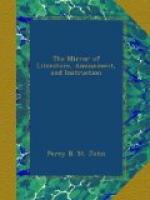trifling pieces for his daily subsistence. After
two years of extreme toil and difficulty, he was relieved
by the arrival of Mignard, the artist, who had formerly
been the companion of his studies. Mignard evinced
the warmest regard for his friend, and they were afterwards
known in Rome by the name of the
inseparables,
for they lived in the same house, worked together,
and united the produce of their labours. They
were employed to copy all the best pictures in the
Farnese Palace, and every evening attended an academy
of drawing. Mignard was superior in practice,
while Fresnoy was perfect master of the rules, history,
and theory of his profession. They communicated
their sentiments to each other, Fresnoy furnishing
his friend with noble ideas, and the latter instructing
the former to paint with more ease and dispatch.
Fresnoy painted several fine pictures in Rome, and,
in 1653, he left that city, in company with his friend,
travelled to Venice, and then to Lombardy. Here
the two friends parted,[3] Mignard returning to Rome,
and Fresnoy to his native city. After his arrival
in Paris, he painted some beautiful historical pictures,
which established his reputation. He perfectly
understood architecture, and drew designs for many
elegant mansions in Paris. During his travels
in Italy, he planned and composed his
De Arte Graphica,
an excellent poem, full of valuable information, and
containing unerring rules for the painter. This
poem was twenty years in hand, and was not published
until three years[4] after the author’s death,
which took place in 1665. It has been observed,
that Fresnoy possessed the genius requisite for forming
a great master; and had he applied himself more strictly
to painting, and educated pupils, he would doubtless
have proved one of the greatest painters France ever
produced. But, possessing high literary talents,
he chose to lay down
precepts for his countrymen,
rather than to present them with
examples of
his art. He adhered too closely to the theory
of painting, neglecting the more essential part—practice.
[3] When Mignard returned to Paris
in 1658, he again went to reside
with his
friend.
[4] It appeared at Paris, in 12mo.,
with a French translation by
Mons.
Du Piles, 1668.
In the reign of Louis XIV., Nicholas Poussin distinguished
himself as a painter, by displaying exquisite knowledge
and great skill in composition. He generally
painted ancient ruins, landscapes, and historical figures.
He was likewise well acquainted with the manners and
customs of the ancients; and, though he educated no
pupils, and never had any imitators, his pictures
are universally admired in every European country.
Charles le Brun[5] established the French school,—an
undertaking which Voueet had previously attempted.
Le Brun drew well, had a ready conception, and a fertile
imagination. His compositions are vast, but, in
various instances, they may justly be termed outre.




